#both are very homoerotic however
Explore tagged Tumblr posts
Text
I genuinely seriously read all for the game because I saw a ginger main character in fanart and thought it was gonna be similar to haikyuu
#so you bet I was quite taken aback when the mafia came into play#both are very homoerotic however#must do anything for the GAME ass series#I have texts to my friend when I started reading it saying ‘I think it’s gonna be similar to haikyuu’ and then update texts going#‘nope definitely not like haikyuu’#aftg#all for the game#haikyuu
26 notes
·
View notes
Text
DanandPhilCrafts + Fucked Up Queer Devotion + Christian Homophobia: An Essay
We’ve all been talking about the willingness of Dan and Phil to perform the ritual, we’ve all been talking about the intimacy of carving out your lover’s heart, but I have not heard anyone talk about the fucked up side of Dan and Phil’s (fictional) relationship with each other, and with Him, so here goes.
On the craft channel, Dan and Phil act overwhelmingly positive, like satanic children’s show hosts, but this is clearly a farce. We see them drop their smiles quite a few times during the crafting- most notably in Glitter Faces when Dan’s craft turns out wrong, and when Phil cuts Dan’s hand. “Don’t cry, craft” is directed towards the audience, but it seems Dan and Phil are following their own advice. Cults, after all, prey on vulnerable people. While they do seem scared of doing the ritual, and their involvement with Him, they are, however, definitely willing. In
The blood on Dan after he kills Phil is interesting; The handprint on his shirt isn’t a sign of a struggle, but rather Phil just grabbing his shirt- that’s pretty intimate, honestly. The blood on his face could’ve been caused by a bunch of things: blood splatter he wiped at? wiping at his face (eyes?) with a bloody hand? or Phil holding his face? (I like the third option) The blood on his nose might totally have been accidental, and just a thing that happened, but it could also be an allusion to the cat whiskers, in the spirit of bringing things back to the beginning and whatnot.
After the ritual is complete, there’s the obvious tarot symbolism. @freckliedan has a great post about this, but I’ve got more to add, so bear with me. Yes, Dan and Phil are framed as the lovers, but that’s not all. While the sexual deviance associated with the devil card has clear connections to queerness, it’s main association is usually unhealthy relationships and dependence. From this, and the obvious devotion displayed in the video, the craft versions of Dan and Phil are implied to be unhealthily dependent on each other, and devoted to the point of obsession. While the relationship certainly isn’t abusive, this obsession just isn’t healthy.
Furthering the unhealthy relationship idea is when Phil calls Dan “Sampson”. In the Bible or whatever (I’m not Christian sue me) Sampson topples these pillars, killing both himself and his enemies, which has a clear parallel to Dan’s stacked ingredients falling over, but the use of “folly” is interesting, and suggests a further connection. Sampson had married a prostitute, and she sold him out, basically, leading to his enslavement and later death. In this story, this is the clearest and most obvious act of folly by Sampson: marrying someone who he shouldn’t have, someone who it was taboo for him to be with. Connected to Dan and Phil, it suggests that their relationship is dangerous due to the social taboo, but it’s also implied that Phil will betray Dan. Perhaps we’ll see that in a 5th crafts installment, or perhaps it’s simply a commentary on being in a relationship with someone considered unacceptable.
Speaking of unhealthy relationships, that’s sure what they’ve got with Him! Leading up to the ritual, Dan and Phil are shown to be scared of Him, even though they call Him their friend. Dan’s head shake when Phil says “crafting has improved my life in numerous ways” is very telling. At the end, Dan’s shoulders tense at His first footstep, however, when He actually touches Dan, he doesn’t seem scared at all- forgive me for this next point, but from the way he kinda leans into the touch and tilts his head back, it seems more like he’s going for “turned on” rather than “scared”.
“Okay, cool” you say, “but what does it mean?” Well, Dan and Phil’s relationship in this series is not just about homoerotic undertones- this is an allegory for toxic queer sexual relationships. Why would they make something about toxic relationships when they’re in a healthy relationship? With the toxicity, and the power imbalances, and the satanism, Dan and Phil’s (fictional) relationship is a representation of Christian fears of queerness, and the supposed immoral/corrupting/anti-Christian effects of being in a queer relationship. The fear Dan and Phil show throughout the series is representative of internalized homophobia. They’re scared to align themselves with Him because it means accepting their own queerness. Dan shows more fear than Phil throughout the series (like after his glitter face turns out to be a pentacle) which parallels his real world internalized homophobia that he’s experienced. By holding hands with the devil (or baphomet?) standing behind them, Dan and Phil have embodied every conservative fear about queerness, but have come out on top. Through their YouTube channel, we get to do the same.
#in conclusion:#if DanandPhilCrafts is about anything#it’s about how it’s okay to be gay#lol#thanks for reading if you made it this far :)#I would love to hear other people’s thoughts on this!#dnp#dan and phil#phan#amazingphil#daniel howell#danandphilcrafts#dan and phil crafts#phandom analysis
456 notes
·
View notes
Text
some other adventures from this have been
three CONSECUTIVE scenes of kuwabara going "you're NOT gonna die on me again urameshi :((" during genkai's tournament. they JUST cut to him for that and then cut away it's SICKENING. like heyy reminder that kuwabara was traumatized a bit by yusuke's death teehee and then back to like. exploding shuriken fights
realizing how much they lean into the "fight me fight me fight me" stuff in the rando arc and how much less that's the case with time because like. they actually become friends who have other stuff to talk about now :)
great beasts/maze castle/saint beasts/WHATEVER arc (and genkai's tourny) has just. they're telling each other to shut up Constantly like even more than i thought
i think i mentioned this a while back but im working on an "every kuwameshi" video right (yes it's ridiculous i know somebody take them away from me) and i just need to say im so fucking sick of editing the saint beasts arc </3 pls i love that one normally but this section of the video is like. 70% silent group shots it's so bad and not fun to watch or edit and i hate it :[
#ok i know i said in the tags that i was really committed to the 'EVERY kuwameshi' thing but i might get rid of the shots where thhey're not#like. posing or interacting or talking or anything bc that's just not really worth it#it'd make it faster and probably better to watch#but i'm also worried that my focus on condensing it when i know it's gonna be such a long video#means that it'll be kind of an overwhelming barrage of content otherwise. which wouldn't be good for a long video like this#so group shots like that can create natural breaks. idk i'm not sure#i have not done this before :/ and i hopefully won't do it again with a series this long like holy hell#i will also say that some of the magic of kuwameshi is a little lost in that just because you have no point of reference for like#how they act w each other vs with everyone else. both in similarities and differences#you don't get a good grasp on how common these moments are relatively speaking and you don't get a great sense of their group dynamics#and it actually makes me kind of sad to hone in on only those two because like. everyone is so damn special there#i don't like yyh bc i think kuwabara and yusuke should kiss or whatever it's bc of how well realized these relationships (esp the#friendships and not-quite-friendships) are. they're so multifaceted that focusing on only two characters robs the audience of the context#those moments sit in. kuwameshi + hiei vs kuwameshi + botan vs kuwameshi + genkai are all different and special dynamics and by clipping#only those two it kind of flattens things a little. at least if you don't make an effort to pay attention to the remaining context while#watching. however i love those two and highlighting their relationship specifically doesn't inherently mean that they're the only ones#i think worth your time nor the only characters i care to see them interact with. yyh is very special to me and i don't want to diminish it#by reducing it to something with a couple of peak homoerotic relationships. it's far far better than that#however. since this is a tiny fandom and kuwameshi isn't exactly the most popular dynamic in the world i feel a little better doing so#because it's like.. it's not as if it'll sway the fandom's conversations THAT hard away from all the stuff we love about yyh right?#such that the ship is known before the media itself. at least that's what i hope. there's pieces of media i'm attached to mostly for certai#characters or dynamics and that's usually limited to media i'm not That into. but yyh is MINE and i don't want anyone to think this is all#about it that matters to me. ugh idk why i'm getting so worked up about this i just. don't want it to be reduced to uwu gayboy stuff ig#like yeah uwu gayboys you're not wrong i just. there's More Going On There#and although i like to think i focus on the Other Stuff a decent amount in all the media that means a lot to me it's very important that i#make sure to do that with yyh. i guess.#anyway im also thinking about making a kuwabara cat mention video. i have like 8 lines/scenes i'm thinking of lol#(there's more than i thought so ig i'll wait and as i work keep an eye out for more of em)
7 notes
·
View notes
Text
Achilles and Patroclus: Friends Lovers or both? (An analysis based on Homeric Epics and some ancient sources)
Yet another analysis requested by my dearest friend @artsofmetamoor while we two explore the complexity of human relationships in our own projects including romantic relationships of various kinds, including homosexual and homoerotic material as well as more traditional notions of family and kinship along with the complexity of values such as companionship and friendship, which we hold in the same regard as in the above so here's one of the most discussed relationships in greek literature. Buckle up with me because it is gonna be a looooong ride!
Achilles and Patroclus are two figures of greek literature and mythology that sparked discussions and analysis from the very first time they were introoduced as characters in the homeric poems in 8th century BC and not for their heroics in Trojan War but rather the nature of their relationship. Not to mention in modern day times we also start the rather overused and kinda ridiculous joke of "Historians say" around. But there might be some truth in some concerns in regards to their relationship.
A small history of their family
Achilles and Patroclus were related by a distant ancestor, Aigina. Aigina had a son with Zeus named Aeacus who in turn got married and had Peleus, who has the father of Achilles. Patroclus comes from the same line for Aigina later marries Actor and has Menoetius with him. Menoetius marries his cousin Damocratea, also possible daughter of Zeus and had a son named Opus who in turn had Patroclus, making Patroclus and Achilles de facto first cousins by the line of Aegina
(Yes...sorry "Troy" haters out there...hahaha Patroclus really WAS Achilles's cousin! ^^; Not that it ever stopped anyone in greek mythology!)
Patroclus was ellegedly exiled from his homeland when he accidentally killed his playmate and he fled to the court of Peleus where he got adopted by him thus the two characters lived most of their childhood together. Patroclus by most accounts is quite older than Achilles so in a way he was also assigned not only as his playmate but also as his "squire" or protector in various occasions. Needless to say that of course the two of them developed a very strong bond together.
Greek Text
To be honest, every time some person who does support the theory of them being lovers is being asked on it and that person claims that "the greek text is quite simple really". Allow me to disagree though. It is not. Quite frankly if it were, it wouldn't have sparked the conversation even to ancient greeks themselves of their time!
Arguably Homer never explicitly describes them as lovers in his poems (as opposing to other figures in the text that are undoubtedly sharing sexual relationships in the Iliad such as Hera and Zeus, Paris and Helen or even, ironically Achilles with Briseis once she is returned to him). However one would be a liar if they denied certain insinuations of a romantic involvement betwen the heroes.
Φιλέω-ώ= to love < > φίλος=friend, companion (Substantive), beloved (epithet)
Quite frankly Homer as we said before he a master of words and none of his words is picked at random. And the term φίλος is no exception. The word is being explicitly used in Homer by various of characters. The term can be translated interchangably from either "friend" to "beloved" depending the context. One of the most infamous and touching moments this word is being used is at the lament of Achilles when his mother asks him to speak up on why he laments so hard:

With heavy groans, fast in feet Achilles responded to her: "Oh, my mother! The Olympians have done what they had predicted for me! But what joy remains for me, for my beloved comrade Patroclus is gone! I lost him! The one that I valued most among my other companions, equally to my own life!"
(Translation by me)
In here the concept of "φίλος" is clearly an epithet or plays the role of one since the actual word that we are looking for as a substantive is the word "ἑταῖρος" which stands for "companion" or "comrade" (a term used generally throughout the poems to indicate bonds in army or of friendship or even husband and wife at some cases). In here it clearly means "beloved" by the general text for the word "φίλος" is not used as a substantive. Other cases such as this appear in other parts of the poem even with the fullest form φίλτατος which means "the most beloved"
However it needs to be noted that the term φίλος as the essence of "friend" comes directly from this term "to love" which means someone "you are close with" someone "of your own kin" someone "dear to you". The ancient greeks do not seem to be making a distinction between love as in lovers and love as in family or relatives when using this verb and the words coming from it (one good example is Thetis referring to Achilles as "φίλον υἱὸν" which means "beloved son" and here has no romantic implications at all).
The term is being used interchangably throughout Homer to speak about characters with close relations of kinship that are not linked to romantic essences at all. For example the way Menelaus adresses Odysseus as such in the Odyssey:

Oh, how strange! That has come to my house the son of a man much beloved to me; who for my sake has suffered so many ordeals!
(Translation by me)
In here Menelaus again is usingthe term φίλος but he doesn't speak out of romantic intentions at all. He speaks with the warmest words but in here it is the most intimate form of friendship and kinship and is followed by the implication of gratefulness, how he adds up how Odysseus suffered "for his sake" aka to fight the war and be lost afterwards. And before someone says "it is not the same amount of warmth" one must think again because before Menelaus speaks about how because of the agony he feels for his friend he does not eat or sleep properly and given that it has been 10 years already since the last time they saw each other that is a damn long time.

But all of them I do not grieve as much, even if I mourn for them, as much as I do for one man, because of which I both detest sleep and neglect to eat, for there is no one of the Achaeans that suffered more than what Odysseus suffered and endured
(Translation by me)
So not only Menelaus feels like Odysseus suffered the most out of them (and strictly speaking one can look at fates of other heroes like Diomedes to see they are not far behind in suffering) but that the way he constantly wonders about his well-being makes him unable to sleep or eat and that seems to be happening for years and years which shows the true depth of their friendship.
So no, strictly speaking the word "to love" is not used by the greeks to imply only romantic love and it can be used pretty intimately even if it is not referring to romance. And the difference can be perceived by the same writer as well not just some play that was written several centuries later in which, inevitably, we could talk about some alterations of meaning to the words over the course of time
However there seems to be another phrase used to express intense feelings of love which is κεχαρισμένε θυμῷ which means "dear to my heart" and in Iliad ironically that phrase is spoken by no other than Briseis herself!

Oh, Patruclus! Dearest to my wretched heart!
(Translation by me)
This interesting shout of love coming from Briseis is also interesting for it could be implying both emotions of romantic love but also of affection in general. Which is another phrase that researchers have looked upon in search for hidden meanings of romance but once again it was often used either as such or with the term "φίλος" instead to speak of relationships of family or kinship. But grieving scenes such as the one of Briseis might also be indicator of romance although not exclusively referring to that.
The Lament
Quite frankly speaking, Achilles's lament is one of the most infamous and well-known in greek literature exactly because of its explicit nature. We do see characters lament in plays before but it is not as frequent to see lament SO strong coming from a male character and so openly (see for example in the Odyssey how Odysseus tries to hide his own tears many times or how his men are wrapped up in veils in lament for their own lives and their fallen comrades' but by n large the male lament is more subtle, more silent). Achilles is different. For example when he is first told about the news of Patroclus's death the result is nothing less but the ultimate emotional collapse:

So they spoke and black mist of distress covered him: With both his hands he gathered smoky sand and he poured it over his head and disfigured his face: his nectarous chiton turned black with ashes. And he himself dropped in the dirt and stretched over his lying (here: the corpse) friend/beloved pulling out his hair in lament. The slaves given as war price to Achilles and Patroclus, released a great cry of sadness and they approached all to the sides of mourning Achilles, beating their chests with their hands, and their knees each. Also Antilochus with them was lamenting and pouring tears holding the hands of Achilles: for he was moaning with his noble heart: worried that he would cut his throat with iron (here: a knife).
(Translation by me)
There is no words to express such an intense display of pain given by Achilles from second one when he receives the news of the death of Patroclus. He immediately pours ash over his head (quite a common trope for mourning done by many characters before.) and "disfiguring his face" which means he was digging his nails down his cheeks which was again a trope of mourning in greek literature. The intensity of his lament is so great that Antilochus feels the need to hold his hands just in case he would want to comit suicide in his pain!
Ironically for most part in this lament does it mention that Achilles was making any sound at all during the process, which somehow makes it even more disturbing to think that Achilles simply drops to his knees, covers himself in ashes and scratches his cheeks while lamenting over the body of Patroclus hardly making any sound at all. It is the slave women who arrive later that release the cries that undoubtedly are within the soul of Achilles. Somehow his lament is extreme and yet no audible hint exists for most part of the text EXCEPT the final one where it says "moaning with his noble heart". It almost seems that his body does most of the talking till the women arrive and cry out like he so much wants to and then his mouth also makes sounds. It is not a scream; it is a moan. It is possible of course that the clip refers to Achilles constantly moaning but I do like this as a possible food for thought that if Achilles was firstly responding to pain with his actions and then with his voice and in a way the moment he actually made a sound was the moment Antilochus truly began to worry!
There is a certain theatricality to this scene of lament and drama which of course as many analytics before me would say, it seems to be hinting to some other infamous laments of mythological characters and more specific the laments of Apollo. Apollo is one of those figures for whom we have no doubt he was lamenting his lovers and some classical examples are Hyakinthus and Cyparissus both of them transformed into a flower and a tree respectably. The associations of Achilles and the grieving god seem to be more than just a possibility here. Which of course enforces even further the idea of them being lovers. It is also the amount of time that Achilles mourns plus the intense way that he refuses to let go of the body of Patroclus to which he seems to be holding on from the 18th rhapsody when he first finds out of his death till the moment that she arrived with his armor one rhapsody later. Quite a gruesome scene is when she enters the tent and finds Achilles crying while clasping Patroclus onto him:

And she found her dearest son still lay there, clasping Patroclus and crying woefully and his comrades around him mourning
(Translation by me)
And at this point Thetis hasn't yet given nectar and ambrosia to the body of Patroclus to prevent the sepsis from happening, which happens a few lyrics later. So Achilles was holding the dead body for the entire day even after it was cleaned and prepared showing the intense pain Achilles was expressing and going through. And he seems unwilling to part from him till Patroclus's spirit itself arrives in his sleep and requests a burial so he can rest.
Of course it needs to be noted that intense lament is not exlusive to lovers in greek mythology. To name a few Athena grieves intensely the loss of her friend Pallas and by some accounts she does take her name as her epithet post-mortem. Antigone intensely mourns her dead brother and laments his disgrace when she finds that the ritual burial she performed had been disturbed. And the acting of killing oneself out of sorrow again is not strictly remaining to the love affairs. For example Ismene killing herself after learning the deaths of her family members in general and Antigone in particular. Another most prominient example is king Aegeus who throws himself into the sea when he sees the black sails of the ship coming from Crete, thinking his son was dead.
So the exessive expression of grief are not just dedicated to lovers or husbands and wives in greek literature but rather it is expanded to all people who mourn someone dear to them regardless of the nature of the bond between them. In the case of Achilles of course he does seem to be having a specially strong mental breakdown every time some important person in his life that is said to be romantically involved with him dies or is taken from him starting with Briseis for whom he expresses his emotions many times in the Iliad and she is the first reason of his anger, of course Patroclus and Penthesilea for whom he apparently has feelings for a few monets after he sees her face after she dies. In Posthomerica it is even said that his lamentover her dead body is "the same as the one over Patroclus" and of course Antilochus later according to the Epic Cycle when he died protecting his father, caused another explosion of anger to Achilles which was fated to be his last one.
It is possible since his love is clearly stated in the cases of Briseis and Penthesilea that the same can have occured for Antilochus and of course Patroclus which was the most heartbreaking of them all and for good reason. In fact the case of Patroclus seems to be that he plays every role in the life of Achilles. He is his friend, his companion, his squire, his advisor so why not his lover too.
The Same Urn
Now of course where people surely think they have a clear case of romantic bond seems to be the request of Patroclus to be burnt but his bones to be kept in the same urn that is to be used for Achilles as well. The passage happens in the 23rd rhapsody:

And one more thing I ask for you to excecute; do not place my bones apart from yours, Achilles, but together just like we were raised in your chambers, when I was brought to your land by Menetoios as a little boy from Opois because of the grievous manslaughter, for when I was a child I was foolish and killed the son of Amphidamas without wanting to, for I was mad over a game of dice: there I was accepted to the chambers of the horseman of Peleus who kindly took care of me and named me your squire. And the same way I want for my bones to be together with yours in the same golden box, the one your divine mother prepared for you.
(Translation by me)
So apart from the fact that it is a highly emotional scene, seeing your dead companion arriving at you and begging to be let go (this is literally Patroclus saying "Let me go, Achilles...just let me go" for Achilles literally refuses to give up his body not even for a burial) it is also the scene that seems to be winking to the fans of the idea of them being lovers as a proof that they are together. And quite frankly I can absolutely see why and it would be foolish to ignore this possibility especially given how tenderly Achilles calls him "my beloved" (or "as loved as my own life") after the whole request is done from the spirit of Patroclus which is more than clear indication for many accounts and that makes perfect sense.
The custom of co-burial was known in Greece from the earliest times of its civilization till the end (because quite honestly I am not sure the custom will stop existing in Greece since despite the lack of cremations, we still have the custom of common graves even if it is only for those who can afford have a family monument). We often find urns contain bones of multiple individuals and yes more often whatnot they are maritable partners and the obsession of words that mean "together" in this passage such as; "μή (...) ἀπάνευθε" (not apart), "ὁμοῦ" (at the same place, together) or "ἀμφικαλύπτω" (cover each other) seems to be pointing to the direction of a romantic relationship and it won't be the only time someone is co-relating the mingling of ashes and bones with "marriage" (and example is The Hunchback of Notre Dame, where Victor Hugo describes the way Quasimodo and Esmeralda's skeletons turn into inseparable dust as "Quasimodo's Marriage")
However on the counter-talk, co-burials were also common among family members (which is exactly what Achilles and Patroclus are). Ironically from the excavations to Mycenae several co-burials were discovered that were not related by blood but they were theorized to be connected to some relations of adoption (which again seems to fit the case of Achilles and Patroclus from the time Patroclus was brought in and ellegedly adopted by Peleus)
I am also convinced that the fact Patroclus gives us some good portion of his background story here was not just a random thing. It seems that Patroclus places emphasis on why he wants to be in the same urn as Achilles; because they were raised together, they were together all their lives and he wants them to be together in death as well. It absolutely could be a romantic insinuation on Patroclus's part however it seems equally possible that the background story serves as a lever to make the public understand how the two of them were raised together and wished to remain together. It almost feels like Homoer wants either to stimulate the idea that the past is an extra point towards their romantic relationship or yet another point of the closeness of their kinship or both (to me it seems the latter)
However another factor to this urn seems to be Antilochus. Antilochus who was close to the age of Achilles, the one who was in charge to bring the news of Patroclus's death to Achilles and the one that we saw consoling him and trying to prevent him from doing something foolish seems to be added to this circle. In fact in some future sources he is featured as the reason Achilles died, for he was driven in yet another furious attack against the Trojans, forcing them to fall back when he saw him fall dead protecting his father from the Ethiopian king Memnon. In some accounts, even possibly Homer included, is insinuated that Antilochus was also included in the funerary urn with Achilles and Patroclus although in the Odyssey it is clearly stated that his bones are not in it:

Your mother gave me this golden amphora (here an urn with two handles); a gift from Dionysus she said to me, made by the renounced Hephestus, in which lie your white bones, radiant Achilles, mixed with the ones of dead Patroclus son of Menoetius, but without Antilochus, whom he honored above all his comrades after Patroclus died.
(Translation by me)
So in the Odyssey it doesn't seem like they were indeed in the same urn (unless somehow Nestor could tell the bones apart and took them out? hehe) but they all thee of them are joined in one tomb and worshipped as heroes. So in a way Antilochus seems to join them just not in the same box. However the three of them are indeed seen together in the underworld as one trio literally. They are apparently joined after death according to what Odysseus saw in the underworld.
Once again seems like the romantic as well as the kinship theories could be true interchangably or even at the same time.
Ancient Greeks on their relationship:
As I mentioned above many ancient writers and not just the infamous "historians" everyone mocks on the internet, seem to have placed their own guesses and opinions on the relationships of the two heroes.
Aeschines seems to be contemplating the idea they are lovers (aka he says that Homer "hides their love") and he even reads Patroclus's story as "an intercourse they had once". He names their relationship έρως aka romantic love (eros). Aristotle in Nicomachian Ethics and Rethoric he uses the term "comrade" to talk of them, choosing to focus more on their friendship. His teacher Plato though was a different story. He was convinced that they were not only lovers but he had also figured their roles in their relationship as presented in his Symposium, naming Patroclus as ἐραστής aka "the one who gives love" and mentions how Achilles is in love with Patroclus. Plato remains one of the most...great "shippers" of the two having no doubt about their love affair. To the other end is Xenophon who is adamant that they are not lovers, in his own Symposium. A large number of greek writers seem also to comment on both possibilities, it seems to me quite interesting how many different readings the homeric poems provide.
More mordern readings:
While it is true that there is a certain confusion to the public since a large number of texts either were deliberately modified or genuinely mistranslated (given again how terms like φιλώ means "to love" in general in ancient greek and not just romantically or that the term ερώ does mean "to love as a lover" in some contexts but it also means "to desire very much" and it was used in various of contexts) and these double-meanings were taken advantage of to translate the texts differently and that is because when someone in modern times says "my beloved" by n large they refer to a lover which was something that was greatly hushed up in public
Of course as we stated above for ancient greece that was not the case since the term "beloved" could be used in various contexts and it showed intense emotions of kinship between two people regardless of the nature of their relationship.
However in some accounts the obsession upon trying not to show intense potentual homoerotic material made many of these translations unreliable. There were exceptions to the rule of course but the real breakthrough wouldn't really happen till later in the 19th century where we also have more samples of printed work. Translations like Butler at the end of 19th century are far reliable to the text and seem to follow the spirit of Homer. Quite frankly there was already a breakthrough to homoerotic material thanks to not only the neo-classisim but also gothic literature such as the vampire novelle Carmilla so many writers became more bold into translating the tender words of love as they were and leave the public decide upon their nature.
However this effort to hush up the tender words spoken in Homer out of fear that they might be interpreted as homoerotic created of course this modern uprage in which we have the other way round; that people are afraid to talk about friendhsip and kinship because they will be hushed up by the readings of the text as homoerotic
(see my other post for this)
This, in my opinion simply removes all the abive context; that love can be expressed between family members or friends or people who have been through a lot. Quite frankly as you can see not only I am not denying their energy as lovers, I like to believe I am also supporting this theory a lot because there is a lot of possibility in it just like there is on the direction of tenderness and affection. I do think today people are afraid to speak up on the other side exactly bcause nowadays the most famous way to see them is as lovers as opposed to the previous periods that did the other way round
Conclusions:
I have no doubts that Homer, even though not clearly speaking about it (for example referring to sexual acts) he seems to be insinuating that the two of them were sharing romantic bond or feelings for each other
(it needs to be noted that it is not entirely clear that if there WERE romantic feelings that they were confessed or known by both parties, which could potentially mean the two of them loved each other romantically but did not fulfill their love which could be another tragic note to their story)
Homer seems to be sending several hints to his viewers/readers that one could interpret them as lovers given the tender dictionary they use between each other and for each other, allowing his...fans to decide for themselves. It is also highly possible that he too saw them as star-crossed lovers, for he gives them all the elements of various other stories that involve homoerotic romance, even the tragic end to their story.
However I am equally sure that he also wanted to say that their friendship was of equal importance. There is no doubt that Homer considered them close friends (for he gives us a small hint of their backstory, how they grew together) and their story is being projected like many other duos and characters in the Trojan war that are linked together with bonds of kinship and companionship; stories that flourish at war. He might not straight out tell us that they are the case of story "from friends to lovers" but he absolutely seems to be letting us know that their kinship is there!
And I am grateful to Homer for his writing because it seems to me he wanted both sides to equally enjoy the story; whether they are those who do think their closeness is romance and those who think it is close kinship, strong family bonds or friendship. I am almost convinced that Homer deliberately used that as a way to please both sides of the audience or to give a more tragic aftertaste to their story since closeness is much more impactful to the face of separation.
I like them both and in fact I support them simoultaneously for honestly there is no best lover than your best friend; someone you can trust with everything you have. If I had to support one form of love, this would be it but at the same time I do support the idea that friendship is already a powerful bond of two people and that romantic love in this case would come as a bonus. Somehow Homer does seem to entertain this idea in his writing given again the extreme tenderness and the tragedy of these two while at the same time leaving the door open for his audience to speculate, make interpretations and enjoy the story in their own perspective.
If that is not art I dunno what is.
Okay guys this is only but scrapping the surface of this relationship that lasted for 3000 years now! Hahaha but I hope you like this! It took me several hours to synthesize but I hope you like it.
#greek mythology#the odyssey#odysseus#tagamemnon#odyssey#patrochilles#achilles#patroclus#antilochus#iliad#the iliad#katerinaaqu analyzes#trojan war#troy´s aftermath#sacking of troy#homer iliad#homeric poems#homer odyssey#homer odysseus#homeric epics#just a homeric poem writer and enthusiast#homeric poems inspirations#thetis#briseis#greek myths#greek myth#epic cycle#friendship#menelaus
188 notes
·
View notes
Text
swordfighting observations
when I had only been doing HEMA for a little while, I turned to a friend and said: "this is going to ruin fictional swordfighting for me, isn't it?" and he said, immediately: "yep."
THAT SAID, a lot of live fencing still happens too quickly for me to really track and process what is and isn't happening. so the one fictional swordfighting thing I've always wondered about is the only one I'll speak to here, and that is
TWO SWORDS CLASH IN THE MIDDLE DISTANCE, BLADE TO BLADE. A WITTY QUIP IS EXCHANGED. ONE FIGHTER LEANS IN, TRYING TO EXERT POWER; THE OTHER DOES THE SAME; ONE BEGINS TO GAIN GROUND, FORCING THE OTHER BACKWARDS FROM SHEER FORCE ALONE
hey guys, I'm always thinking at this point. hot stuff, but couldn't you just like...move the sword as soon as it's clear brute force ain't gonna do it?
So I will be talking about the longsword concepts of binding and winding and also some anecdotal observation of my year and change learning both longsword and greatsword.
Obligatory caveat that I'm specifically speaking to concepts as I've learned em as German KDF longsword fencing, or as montante fencing, and I don't do shit with one-handed weapons.
First up: Binding. In longsword, your priorities are as follows: 1) keep the other person from hitting you 2) hit the other person, in that order. In the course of 1, it is pretty frequent that your swords will hit each other and hold. This is called the bind. I'm told that with sharp swords the bind is actually fairly literal; when two sharpened edges, potentially with burs and other rough spots, come into contact, they do lock into place rather than sliding around.
You can have a strong bind, when the lowest and more powerful part of your blade is in contact with the upper portion of your enemy's; a weak bind, when your upper sword is trying to exert pressure on their lower sword; or a neutral bind, where you both meet in the middle, as our lovebirds are doing.
Keeping the bind is actually pretty desirable sometimes, for a very straightforward reason: you know immediately where your enemy's sword is if you're in contact with it, and you have some leverage over it. Being in physical contact with the sword as it moves is much more immediate feedback that trying to visually track and defend against it. So the idea of these two homoerotic duelers maintaining contact long enough to quip is not actually that crazy.
Just sticking there and leaning at each other, however, is. Enter winding! In a nutshell, winding is the act of keeping your sword in the bind but positioning it such that you have an advantage. This can look like moving from a neutral bind to a strong bind, moving the tip of their sword from a threatening position to one where they can't reach you, or getting into a place where you can stab them in the face from the bind or even hit them with the pommel (classic). Physically, you're shifting the placement and direction of the sword, moving from guard to guard (from low on your hip to above your head, or switching side of the body) to try and find the advantage while maintaining pressure on their sword.
With two people who know what they're doing, winding can be very fluid and almost dance-like, as both fencers react to the other person, maintain contact, and fight for control through a series of different positions.
So! In summary, I want to see fewer fictional duelists wrenching their arms and shoulders by struggling to physically shove someone via sword, and more elaborate and flashy maneuvers as they negotiate via swordplay who's on top.
MONTANTE ANECDOTE TIME:
Because the weapon I prefer and click with more is a giant fuckin sword, I am not very good with binding. This was actually the first instance I noted of my greatsword stuff influencing my longsword stuff; when meeting another sword, I have a tendency to try and swing straight through it instead of arresting momentum to meet in the bind. With a montante, this is very easily done, because of the greater weight and momentum, and in fact a big component of the style; you're meant to be constantly in motion to maintain momentum, and you knock weapons away and then swing back around for the second hit. Trying to suddenly stop a montante is how you hurt yourself.
With a longsword, this has mixed results. Benefits: most longsword fencers aren't expecting me to do that, because it's the type of shit a beefy fella very confident in his strength would do, and I am only slightly more intimidating than a pasta noodle. So it sometimes tricks them into trying to react to a bind that doesn't come, and sometimes places my sword out of reach before they know what's happening, and if I am correctly maintaining my own momentum and being smart I can get the hit. Cons: it moves my sword out of position, and when I'm not presenting a threat I get hit. Additionally, if I meet one of those aforementioned beefy fellas and try this I may just get stopped cold, and then I have to wind. Figuring out how to implement this more purposefully than instinctively is on my to-do list as soon as it's cool enough to put on all of my padded sparring gear again.
#a kay in the life#HEMA#longsword#montante#greatsword#sword practice#sword fighting#writing reference
139 notes
·
View notes
Text
something i find intriguing about re-animator (1985) and its sequel bride of re-animator (1990) is how truly similar they are to frankenstein (1931) and bride of frankenstein (1934), SPECIFICALLY in regards to their queercoding. the original re-animator stories were of course, according to lovecraft, written as a parody to mary shelley’s frankenstein. however in the cases of both films and their sequels, they differ significantly from the original source material. interestingly, though, it seems they have a lot in common with each other. sound interesting? read on.
obviously, there are base level similarities in the original frankenstein movie and original re-animator movie. both feature a classic mad scientist figure with the goal to conquer death. and both films end with the supposed death of their mad scientists, along with their creations. but where the real similarities, as well as the heavier queercoding comes in, is with bride of frankenstein, and of course, bride of re-animator.
so, to draw the comparisons and explain the queercoding, we first have to establish the characters, and who they tie to in the other film. first, we look at the classic queercoded mad scientist. in the first movie, herbert west is mirrored by henry frankenstein. however, in bride of frankenstein, the character that more lines up with his character archetype and plot line is dr. septimus praetorius. for those unfamiliar with the character, dr praetorius seeks out henry frankenstein, a former student of his, hoping for his assistance in creating life. although the relationship between dan cain and herbert west is not that of a teacher/student arrangement, we still see herbert seeking out dan’s help in building the bride. and of course, both west and praetorius are often read as queer. with west as praetorius, dan cain falls in as henry frankenstein. both are reluctant to return to the whole re-animating dead bodies business, clinging onto the life of “normalcy” they think they can have, and pushing back against the other man who is trying to draw them back in. dan and henry are both less often read as queer, but if you step back, it’s very easy to see.
now, we can look at the plot and how it influences a queer reading of the characters. aside from the similarities in name, there’s a lot in common in the two movies. early in the bride of frankenstein, praetorius tries to draw henry in with some of his own miniature creations - several small homunculi. this actually sort of mirrors the scene we all know and love from bride of reanimator, where herbert brings the finger/eyeball puppy to life. there’s a little more queercoding in the scene from re-animator. herbert reads almost like a proud father, showing the critter to dan, and it’s then followed by dan telling herbert that he’s “moving out”, coming across as almost a breakup/i’m leaving you moment, which is met with extreme dismay.
of course, in both cases, these small demonstrations aren’t quite enough to sway henry and dan to the cause. praetorius starts by promising henry his original creation, the creature, as long as henry helps him craft a bride, but ends up having to step things up and uses henry’s fiancée, elizabeth, as bait to convince him. sound a bit familiar? in bride of re-animator, herbert convinces dan to join in again on the reanimation with promises that he can return his dead fiancée meg to him. again, this scene plays out significantly more homoerotically, with herbert producing meg’s heart and offering it to dan. yeah. herbert offered dan his heart. and it works. dan’s sold. now, you’re probably thinking, what’s so homoerotic about joining forces with a man just to get your girl back? well. listen. it’s more, in this case on the part of herbert and praetorius. there’s something very homoerotic in using love to entice a man into creating life with you. and yes, technically it is heterosexuality being taken advantage of here. but there’s still a bit of seduction that’s happening. if herbert and praetorius can’t draw the others in the way they’d like to, they know they can take advantage of the emotions on dan and henry’s end.
additionally, we know west and praetorius are queercoded from more than just this specific scenario. it comes through simply in the way the actors portray them, their lines, and their actions. praetorius was intended that way, despite the movie being produced in an era where the hays code was enforced. actor ernest theisger was allegedly told by director james whale, an out gay man, to play the character as an “over the top caricature of a bitchy and aging homosexual.” which. is kind of hilarious. and herbert west is. well. where do i even begin. actor jeffrey combs chose to play him in a Way, and there are nods to herbert’s lack of interest in women throughout both films (to me beyond reanimator does not exist), most overtly shown when one of his coworkers asks herbert if a recently female deceased patient was attractive, and is met with the single most effective “are you fucking stupid” stare i have ever seen. this, in my opinion is clearer than if he would have just declared then and there that he was a homosexual. but i digress. he also shows nothing but disdain and frankly, a little jealousy, towards dan’s girlfriends, slinking away to sulk in the basement and reanimate some random limbs, or, in the first movie, pushing meg out of the frame and physically coming between her and dan in the shot, symbolic of how he promptly pushes her out of dan’s life entirely.
but what about dan and henry? as far as we’ve discussed, they don’t seem to be reciprocating any of herbert or praetorius’s advances. BUT when it comes time to create the titular brides, both dan and henry seem to finally give in to the temptations. of course, there’s the inherent homoeroticism of creating life with another man. and of course, dan choosing to stick with herbert despite what he’s been put through doesn’t make a lot of sense if you don’t consider there might be more than friendship involved there. but what really matters is how they both lean into it towards the end of their respective films, throwing away their chance at a “normal” heterosexual life with elizabeth (in henry’s case) or francesca (in dan’s) to stick with their own queercoded little mad scientists and continue the work. the moment where each of them finally gives in is clear. henry’s comes when the first heart they attempt to put in the bride is not worthy, and he makes an Active choice and asks for another heart. dan’s is in the final seconds before re-animating their bride, when he makes an Active choice, taking the syringe from herbert and asking that he himself be the one to start the process. both men finally go from passively following their counterparts, in dan’s case rather like a dog to its master, to finally making that active choice and turning to the other side. and the other side, represented by west and praetorius and blasphemy and evil science, can also be a symbol of that queerness. they really step into and embrace creating life with that other man, despite the perfectly fine and normal life that they Could have with their fiancées. it can sort of be read as an allegory for homosexuality alongside bisexuality - praetorius and herbert both only have the scientific way of creating life, and no chance at societal “normalcy”, if we read them both as gay. and they bring henry and dan into their queerness, who can be read as bisexual: they have the opportunity to pursue a societally “normal” life. but they also have the opportunity to do the very opposite.
and finally, in true bury your gays fashion, dan and francesca, as well as henry and elizabeth, escape unharmed, while herbert and praetorius along with their creations, are left to die as the building collapses. the creature leaves us with the haunting line “we belong dead”, referring to himself, his bride, AND praetorius. they’re all, in their own ways, a part of a world they don’t belong to. and the same goes for herbert and his creations. in both movies, heterosexuality triumphs, since that’s what we’re supposed to see as “good” and “normal”, fitting in with our good and normal protagonists who both make the last minute choice to save their girls and escape, abandoning the other men to die. despite being queercoded, the idea of being queer cannot be endorsed by the narrative, and so the story must end this way. even in 1975’s incredibly queer film The Rocky Horror Picture Show, which is another frankenstein esque story, the queer creator frank n furter and his creation rocky both die, while janet and brad, a “straight” couple, manage to survive. it’s an interesting take on the idea of being doomed by the narrative that seems to appear in a lot of frankenstein adaptations.
anyways. sorry for yapping so hard but bride of frankenstein and bride of reanimator are so similar to each other that they end up queercoded in very similar ways and follow the same pattern as many frankenstein adaptations. yeah.
#sorry for posting reanimator#matty’s media essays#re animator#reanimator#bride of reanimator 1990#bride of reanimator#bride of frankenstein#the bride of frankenstein#frankenstein#mary shelley#james whale#brian yuzna#jeffrey combs#dan cain#herbert west#dr praetorius#queercoding#queer#queer horror
105 notes
·
View notes
Note
Church dance + Gems au = accidental near-fusion???
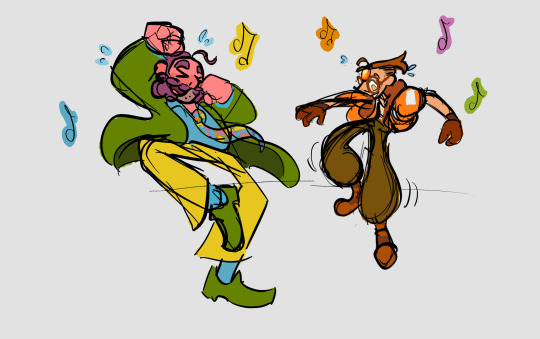
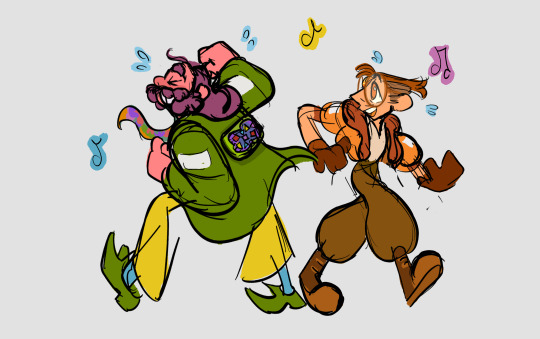

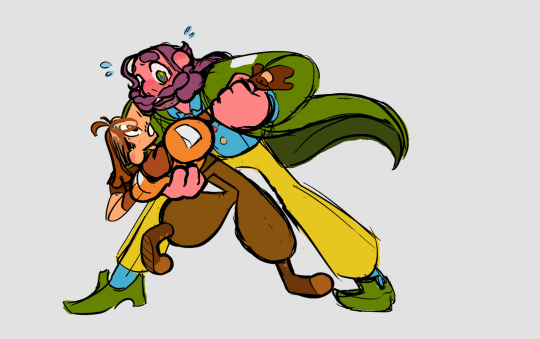
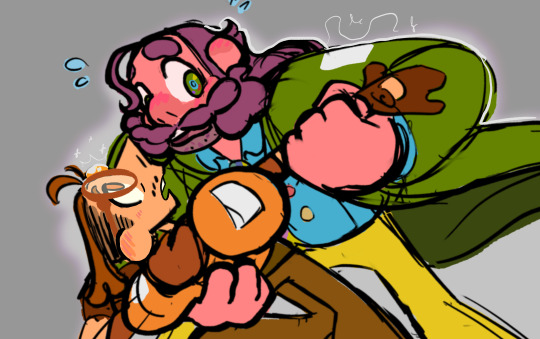


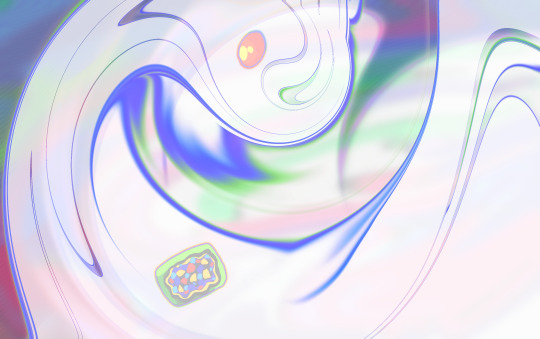

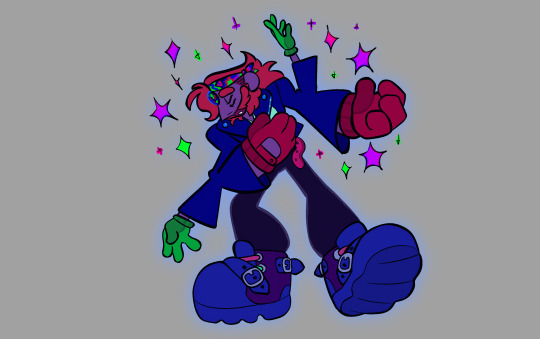

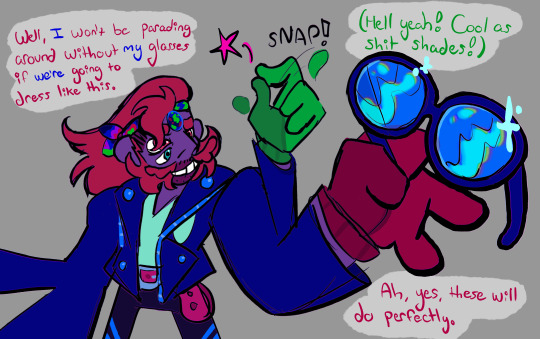

And now, for the main event: Black Opal, the fusion of an Orange Pearl (Kim Kitsuragi) and mystery gem (Harry Du Bois). Below is a reference I made:
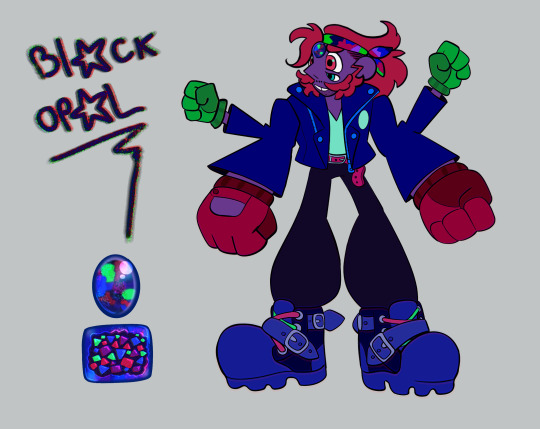
Black Opal, the fusion of Harry and Kim as part of my Disco Elysium / Steven Universe crossover AU. I really wanted to lean into the nostalgia and adrenaline junkie aspects of both characters. The conclusion I came to was a 70s biker. I think every time I've seen a picture of someone's american dad back when they were younger, it was a guy with insane facial hair and a homoerotic biker fit, which lead me to this as the aesthetic for a fusion of these two. These are black opals, for reference:

As a fusion, they both struggle to speak as a singular being. They are not a very stable fusion, mostly due to Harry's damaged gem and how quickly they both can diverge from each other in action and personality. When they do agree however and can maintain Black Opal, its the aspect of themselves that brings out the daring qualities of the other; the one that says "hold on!" and presses their foot on the accelerator, the one that revs their engine, the one that brings a boombox to a boat ride. After a while Black Opal is able to assimilate both aspects of Kim and Harry, as seen in the last panel where his enthusiastic and showboating personality (which both Harry and Kim posses individually in different ways) becomes more like a singular being, like other fusions in the show.
I arranged their limbs and eyes according to where I think they diverge in terms of personality and what they try to accomplish as a fusion / where their interests conflict. This seems to be the case for fusions in Steven Universe as well, where the less harmonious a fusion is, the less proportional the limbs and eyes are to a human body. Harry and Kim have divergences in their eyes and in their forearms. While physically they follow each other in a common goal, Harry and Kim have different ways of handling the world and diverge in their sense of interfacing. Kim has a delicate touch generally, while Harry tends to brute force his way through obstacles. They also have divergent eyes; They both see the world very differently and have different reactions to the same stimulus. Besides these two divergences, they are a fairly harmonious fusion physically.
This is Kim's first fusion, meanwhile Harry has fused before with multiple people from Precinct 41 and his ex, but due to his amnesia he doesn't remember that he has.
Harry and Kim are both basically in historical cosplay throughout the entire game, and I liked the idea of them both being a fusion that dresses in an outdated and charming way as well, like a person out of time. Black Opal as a gemstone I chose because the rainbow coloration of Harry's pale damage on his gem would intermingle with Kim's orange pearl, while the orange and green of the two of them mixed as colors would be a darker muddy color. Thus, this would equate to a dark gem with rainbow coloration inside. Opals tend to be porous as well, which I found fitting for Harry's eroded gemstone.
I love how Harry and Kim have whack-ass facial hair in game and I wanted to give them both an insane facial hair combo. The leather jacket is basically a combination of Harry's green disco blazer and Kim's orange bomber jacket. Kim's gloves become biker's gloves, the "tie" from Harry is the bandana they both wear around their mullet with buzzed sides. They're wearing these big biker's boots, which are drawn largely from Kim's boots in game. Kim has a ton of little compartments to his clothes, so I liked the idea of there being a bunch of zippers everywhere. I'd have put even more and drawn on some patches but my hand was starting to fall off from drawing so for now this is it.
I'll definitely be drawing more of this fusion and for this AU in the future but if you guys have suggestions, ideas, art requests for the crossover let me know. The tag for posts about this au is "disco universe".
Below are some of the clothing and aesthetics I referenced while drawing Black Opal:


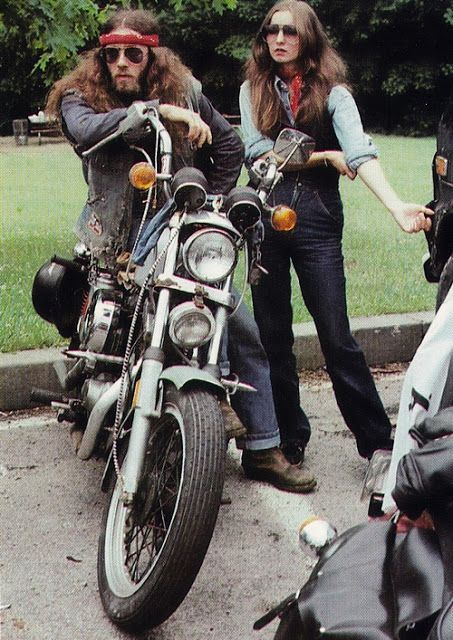

#disco elysium#comic#my art#art#digital art#harry du bois#kim kitsuragi#harrykim#disco universe#steven universe crossover#disco elysium au#disco elysium crossover#steven universe gemsona#steven universe fusion#disco elysium alternate universe
272 notes
·
View notes
Text
On Carlo and Romeo's relationship & homosexuality in Victorian schools
In my quest to find out more about Carlo and Romeo's lives at Monad Charity House, I have once again resorted to my tried and tested method of historical research, this time with a primary focus on Victorian boarding schools.
Along the way, I stumbled upon Lord Alfred Douglas, aka "Bosie" Douglas, the lover of Oscar Wilde. As people familiar with them may know, their gay romance caused quite a stir in 1895 due to the (in)famous trials of Wilde for “gross indecency”, the tragic result of which was that the latter was convicted to two years of hard labor that ruined his health.
Both already had their fair share of gay affairs beforehand though - Bosie specifically was very popular among his peers during his time at Oxford University, being excellent at sports, artistically gifted and incredibly handsome, so it's not too surprising he hooked up with some of his fellow students. What absolutely had me rolling on the floor was this statement, however (quoted from this page):
"[...] we argue that the English public schools in the last part of the nineteenth century tolerated, if they did not actually encourage the development of strong homoerotic friendships between students."
Apparently, homosexuality in boarding schools was so common people made off-hand jokes about it. In the novel Rites of Passage by William Golding, the protagonist finds a fellow traveler engaged in oral sex with a sailor, thinking of it as "that silly schoolboy prank". Admittedly, Golding wrote his novel in the 20th century, so we don’t know for sure if the 19th-century attitudes portrayed in it are accurate, but this might imply that sexual interaction between schoolboys was fairly common.
In the first edition of Tom Brown's School Days by Thomas Hughes, published in 1857, there was even a passage of the protagonist insulting two boys who were clearly in a sexual relationship with senior boys, with the author commenting that "everyone who studied at Rugby would understand why this passage was necessary". (Hughes himself was Christian and condemned homosexual relationships; the concerning passage was cut out in later versions).
This does not mean, however, that all the boys attending boarding schools were gay - rather, because boarding schools were restricted by gender, they had their first sexual experiences in this male-only environment. Many of them would try the exact same thing out with a girl later and find they enjoyed it much more. However, there were also those who never felt any desire to try it out with a girl - and given how close Carlo and Romeo were, I would honestly be more surprised if there wasn’t anything romantic going on between them.
I mean, it’s not like the entire LoP community isn’t already shipping Carlo and Romeo, but in case there was ever any doubt about it, take it from me: I’m positive these boys were gay.
And in case anyone feels like pointing out that “well, actually, the setting of Lies of P is based on France”: Homosexuality was already decriminalized in France as early as 1791 by the National Constituent Assembly, making France the first Western European country to do so - or rather, the penal code drafted with the intention to only punish "real crimes" made no mention of homosexual acts in private. Still, it was a major step for gay rights.
#lies of p#lies of p carlo#lies of p romeo#carlo x romeo#carmeo#they are gay your honor#gay history#victorian england#also still got this out during Pride Month yay!
96 notes
·
View notes
Text
Here is my medieval lesbian nun essay for those interested!
Her Noble Beloved: Lesbian Eroticism and Faith in Medieval Convent Life
For almost as long as nuns have existed, the existence of lesbian nuns has been a topic of endless speculation, derision, titillation and fascination, and yet very little is known about the actual lived experiences of the nuns who engaged in such relationships. Because of the fact that women have been mostly ignored throughout history both in their own times and by historians, and the fact that homosexuality has been both loosely defined and hidden throughout most of Christian history, it is difficult to put together an understanding of who the lesbian nuns of the Middle Ages were, what their lives were like, or what defines a woman as lesbian at all. In more recent years, there have been several sources collected uncovering a hidden history of medieval nuns who could be understood as lesbians, either through engagement in homosexual acts, envolvement in passionate close friendships and/or creation of homoerotic literature and poetry.
However, even though there is now a general agreement that lesbian nuns have existed and even some information on how they lived their lives, there is still a common misconception that lesbian sexuality in convents existed despite or even in contradiction to the faiths of the nuns involved. This is assumed because throughout its existence the Catholic Church has condemned homosexuality. However when looking at the records left behind by nuns themselves, it becomes clear that they did not see their lives in that way. I will argue that not only did many nuns view their lesbianism as an important and positive part of their faith and relationship with Christ, but that understanding lesbian nuns is integral to understanding the role of nuns and convent life in the history of Christianity overall.
In order to develop a fruitful understanding of the ways in which lesbianism has played a role in the history of convent life, it is first necessary to define the term “lesbian” as it is being used in this paper. “Lesbian” in the modern sense refers to a particular social and political category and identifier for women who engage solely in romantic and sexual relationships with other women. This definition has emerged mostly in the past 150 years, and is not applicable for understanding the lives of women in the Middle Ages. There was no such thing in medieval Europe as an identity for homosexuals, rather there were only people who engaged in homosexual acts. The few records of female homosexual sex acts in the era are all from records of legal proceedings and criminal persecutions, and those acts were grossly misunderstood. If it is difficult to uncover histories of male homosexuals, it is even harder to create lesbian histories because, as Judith M. Bennett simply explains, “Women wrote less; their writings survived less often… and they were less likely than men to come to the attention of civic or religious authorities.”
Furthermore, since the historical understanding of homosexuality at the time has been defined solely on the basis of sex acts, it ignores “the evidence… of intense emotional and homoerotic relations between medieval nuns.” Bennett explains. Both the modern and historical definitions of female homosexuality are not appropriate for understanding a history of lesbian women in the historical contexts they existed in. Because of this, I am using part of Bennett’s definition of “lesbian-like” as “women whose lives might have particularly offered opportunities for same sex love.” This is how the term “lesbian” should be understood as it applies to the women discussed in this paper.
Some medieval convents were places of learning and scholarship, where nuns were not only literate and well read but produced works of theology, poetry and literature. In some of the works that were produced in these convents, there can be found poetry and prose which celebrates amorousness and homoerotic love between women. Hadewijch, a thirteenth century Flemish Beguine (woman who lived in monastic poverty without taking official vows), wrote often on the theme of Minne, or love, the same word often used in secular romantic poetry of the time. In Hadewijch’s writing, the Minne she expresses towards her fellow Beguines is inextricably linked with her love of Christ. As Professor E. Ann Matter explains, “these writings stress that only through the imperfect experience of earthly love can union with the heavenly lover be glimpsed.” In Hadewijch’s “Letter 25,” the section addressed to a fellow Beguine named Sara is a clear example of the important relationship between lesbian love and love for Christ in the monastic lives of women.
“Greet Sara also on my behalf, whether I am anything to her or nothing.
Could I be fully all that in my love I wish to be for her, I would gladly do so; and
I will do so fully, however she may treat me. She has largely forgotten my
affliction, but I do not wish to blame or reproach her, seeing that Love [Minne]
leaves her at rest, and does not reproach her, although Love ought ever anew to
urge her to be busy with her noble Beloved. Now that she has other occupations
and can look on quietly and tolerate my heart’s affliction, she lets me suffer. She
is well aware, however, that she should be a comfort to me, both in this life of
exile and in the other life in bliss. There she will indeed be my comfort, although
she now leaves me in the lurch.”
The intensity of Hadewijch’s love for Sara is apparent in this writing, and as Matter puts it, “whether or not their relationship was explicitly sexual, it seems a possible interpretation that Hadewijch and Sara were ‘Particular Friends.’” Notably, it is through this love that Hadewijch urges Sara towards the “noble Beloved,” Christ. The lesbian affections present are far from a contradiction of Hadewijch’s faith, rather they are an integral part of it.
In other works produced by nuns, the passionate love expressed between women extends into the territory of the erotic. In one poem written by an unknown author in the twelfth century in a Bavarian women’s monastery, the female poet addresses another woman in the style of finamour- courtly love- with the poet acting as the lover and the subject the beloved.
“To G.; her singular rose
From A. the bonds of precious love.
What is my strength, that I may bear it,
That I should have patience in your absence?
Is my strength the strength of stones,
That I should await your return?
I, who grieve ceaselessly day and night
Like someone who has lost a hand or a foot?
Everything pleasant and delightful
Without you seems like mud underfoot
I shed tears as I used to smile,
And my heart is never glad.
When I recall the kisses you gave me,
And how with tender word you caressed my little breasts,
I want to die
Because I cannot see you.
What can I, so wretched, do?
Where can I, so miserable, turn?
If only my body could be entrusted to the earth
Until your longed-for return
Or if passage could be granted to me as it was to Habakkuk
So that I might come there just once
To gaze on my beloved’s face-
Then I should not care if it were the hour of death itself.”
This poem is quite remarkable for its seeming overt lesbian sexuality, to the point that John Boswell has called it “perhaps the most outstanding example of medieval lesbian literature.” However, although the content of the piece itself is exceptional, it is fairly conventional in terms of structure and themes. It is composed of rhymed couplets and, Matter explains, tonally echoes the spirituality of medieval readings of the Song of Songs. Even as the piece pushes the boundaries with its eroticism, it harkens back to and celebrates a deeply rooted Christian faith in its language and style. Additionally, Matter notes that the piece fits within “the sophisticated and venerable tradition of spiritual friendship.” And its theme of “longing for the absent beloved” situates it among the many works of verse on the topic of courtly love, a concept also explored by Hadewijch in her writing.
While Hadewijch expressed affection and intimacy for her monastic sisters, and the anonymous poet above composed erotic love verses, one later nun’s lesbian affair made her an exceptional and outrageous figure- and an invaluable reference point for understanding the complexity of lesbian nuns’ relationships with their faith, Christ, and the Church.
Benedetta Carlini was an exceptional woman even before the sex scandal which she is known for. She became a nun in a fairly common way, being brought to a convent at the age of nine by her parents. She was from a well-off family as evidenced by her literacy, and managed to become Abess of the Convent of the Mother of God before the age of 30. She is best known, however, for her sexual relationship with fellow nun Bartolomea Crivelli which was documented in Ecclesiastical records from 1619-23. While this places her in a slightly later time period than the other women discussed in this paper, it is still important to consider her case as it is the most well documented case of a sexual relationship between nuns in the Medieval or Early Modern period, and furthermore much of the detail is taken directly from the testimony of Bartolomea, albeit recorded by a male scribe. While it is important to note that the truth of the relationship may be obscured by the women’s attempts to minimize their actions as well as the misunderstandings and misgivings of the authorities creating documentation, it is still a remarkable record of the life of a lesbian nun and how her faith was deeply interwoven with her sexuality.
One document describes the sex acts of Benedetta and Bartolomea in detail. However, Judith C. Brown notes, “because [the authors] lacked an imaginative schema to incorporate the sexual behaviors described, they had a rather difficult time assimilating the account.” She further explains that as the sex acts are described, the handwriting of the document itself deteriorates and words are crossed out, rewritten, or completely illegible.
“For two continuous years, two or three times a week, in the evening after disrobing and going to bed and waiting for her companion, who serves her, to disrobe also, she would force her into the bed, and kiss her as if she were a man she would stir herself on top of her so much that both of them corrupted themselves because she held her by force sometimes for one, sometimes for two, sometimes for three hours. And [she did these things] during the most solemn hours, especially in the morning, at dawn. Pretending that she had some need, she would call her, taking her by force she sinned with her as was said above. Benedetta, in order to have greater pleasure, put her face between the other's breasts and kissed them, and wanted always to be thus on her. And six or eight times, when the other nun did not want to sleep with her in order to avoid sin, Benedetta went to find her in her bed and, climbing on top, sinned with her by force. Also at that time, during the day, pretending to be sick and showing that she had some need, she grabbed her companion's hand by force, and putting it under herself, she would have her put her finger in her genitals, and holding it there she stirred herself so much that she corrupted herself. And she would kiss her and also by force would put her own hand under her companion and her finger into her genitals and corrupt her. And when the latter would flee, she would do the same with her own hands. Many times she locked her companion in the study and making her sit down in front of her, by force she put her hands under her and corrupted her; she wanted her companion to do the same to her and while she was doing this she would kiss her. She always appeared to be in a trance while doing this.”
The prurient detail of the document is astonishing considering the sexual taboos of the time, however what follows is even more fascinating as the Benedetta’s role in the affair takes on a fascinating mystical and religious element.
“Her Angel, Splendidiello, did these things appearing as a boy of eight or nine years of age. This Angel Splendidiello, through the mouth and hands of Benedetta, taught her companion to read and write, making her be near her on her knees and kissing her and putting her hands on her breasts…
This Splendidiello called her his beloved; he asked her to swear to be his beloved always and promised that after Benedetta's death he would always be with her and would make himself visible. He said I want you to promise me not to confess these things that we do together, I assure you that there is no sin in it; and while we did these things he said many times: give yourself to me with all your heart and soul and then let me do as I wish...
He made the sign of the cross all over his companion’s body after having committed with her many dishonest acts; [he also said] many words that she couldn't understand and when she asked him why he was doing this, he said that he did this for her own good. Jesus spoke to her companion [through Benedetta] three times, twice before doing these dishonest things. The first time he said he wanted her to be his bride and he was content that she give him her hand, and she did this thinking it was Jesus. The second time it was in the choir at 40 hours, holding her hands together and telling her that he forgave her all her sins. The third time it was after she was disturbed by these affairs and he told her that there was no sin involved whatsoever and that Benedetta while doing these things had no awareness of them. All these things her companion confessed with very great shame.”
The role of Benedetta’s apparent spiritual visions in her lesbian affair raises numerous questions, the answers to which can only be speculated on. One of the most obvious considerations is the possibility that Benedetta did not in fact believe in what she was saying, and simply lied to excuse her behavior and prevent Bartolomea from going to the authorities. I believe this can be refuted on the grounds that Benedetta reported many other miraculous experiences during her life which had no association with her affair. In fact, it was during an investigation into claims that she had been visited by Christ and male angels and received stigmata that the affair was discovered in the first place.
It is entirely possible that Benedetta really believed in some or all of the experiences she claimed to have. There were many cases in the time period of nuns claiming to have visions from Christ or angels, and even precedent for those visions being in an eroticized context as in the experiences of the 12th century Hildegard de Bingen, a fellow abbess who was venerated after her death and recently canonized as a saint. While on the surface Benedetta’s claims of being possessed by Jesus during lesbian sex acts may seem outrageous, they can be better understood within the culture of the “heavenly bridegroom” which positioned Christ as a husband figure to nuns. As seen in the above writing of Hadewijch, there is precedent for situations in which the Christ as husband figure worked to sublimate lesbian desires between nuns. While Benedetta’s case is certainly an extreme version of that dynamic, it is not necessarily as idiosyncratic as it seems at first glance.
Ultimately, it is clear that rather than lesbianism contradicting their faiths, many medieval lesbian nuns actually used faith as an integral part of their lesbian affections and relationships. Be it a scorned lover urging her sister beloved to follow the noble Beloved, a monastic woman using biblical style and allusions in her erotic poetry, or a nun enacting lesbian sex acts as part of purported visions from Christ, faith played an essential part in the experience of many medieval lesbian nuns. In order to build a clearer and better rounded understanding of these women and their lives, we must unlearn the assumptions we have based on homophobic and heteronormative histories, and begin to meet these women as they understood themselves and their faith on their own terms.
Works Cited
Bennett, Judith M. “‘Lesbian-Like’ and the Social History of Lesbianisms.” Journal of the History of Sexuality 9, no. 1/2 (2000): 1–24. http://www.jstor.org/stable/3704629.
Brown, Judith C. “Lesbian Sexuality in Renaissance Italy: The Case of Sister Benedetta Carlini.” Signs 9, no. 4 (1984): 751–58. http://www.jstor.org/stable/3173632.
Matter, E. Ann. “My Sister, My Spouse: Woman-Identified Women in Medieval Christianity.” Journal of Feminist Studies in Religion 2, no. 2 (1986): 81–93. http://www.jstor.org/stable/25002043.
#my writing#lesbian#dykeposting#wlw#sapphic#lesbian history#lgbt history#women's history#renaissance#medieval#christianity#history of christianity#essay
39 notes
·
View notes
Note
at this point I think it’s more likely we’d get lestappen as team mates at either ferrari or mercedes before red bull. idk if toto would pull a move like that cause he seems (almost uncomfortably) close with george, but that would be insane (and kinda hype) if we got lestappen title fight in a dominant mercedes car in ‘26…
i still stand that max would die at ferrari, if they don't actively seek him out and attempt to change the company for him (which they wont), he would burn maranello to the ground.
mercedes, however, is an option for both if the development goes well. they are very corporate and can mend their brand for the driver that they have and have experience with title battle between two teammates with homoerotic teenage situationship
74 notes
·
View notes
Text
all of layton and nikita's strictly dances ranked CORRECTLY by ME
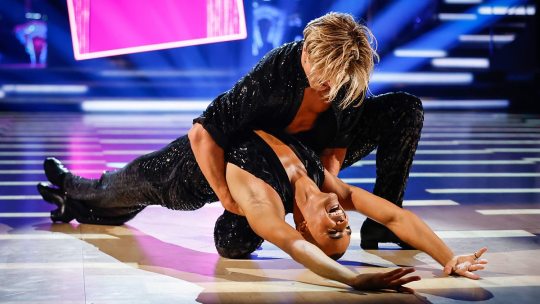
14. Samba, Week 1

unfair to have to rank this one really because nobody really knows what they’re doing in week 1. FASCINATING to go back and watch this though. obvs this is strong in the context of a first week dance! but knowing where they’re going to go from here… this is the one and only time you can see that nikita is dancing layton through the steps and keeping him afloat. they’re not yet a PARTNERSHIP here. they don’t KNOW each other!!! anyway good luck to these boys with navigating what they are going to experience over the next three months <3
13. American Smooth, Week 10

the infamous bottom-two dance. a result which i believe was undeserved!!! but the american smooth IS the most boring category on strictly unfortunately, so it’s a humble placing for this one. i did not love their outfits, for once! why don’t they go together. why does nikita look like peter pan. however, obviously i liked it when they both picked each other up and did a little skip in the air. also enjoyed how much craig enjoyed being bammed up by the ending.
12. Rumba, Week 12
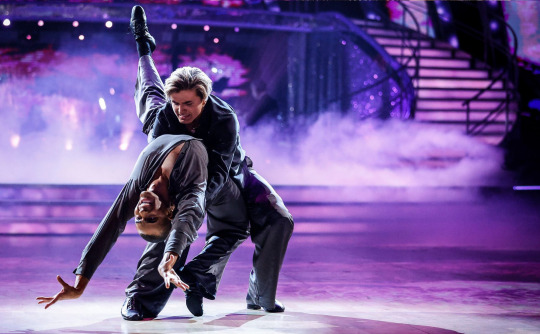
controversial to place this so low in the ranking perhaps?? obviously this was a complex routine that they performed beautifully AND was very tender and intimate. but the rumba is the second most boring dance on strictly after the american smooth i’m afraid I’M SORRY. however, points awarded for nikita saying afterwards that dancing this felt like the rest of the world fell away and they were the only two people in existence. girl what
11. Salsa, Week 5

a great dance! fun! good vibes! their first lift! followed by a bit that i like where nikita has to sort of kick layton upright again. loses points ONLY for being perhaps their least homoerotic dance, which one of them, i guess, has to be.
10. Tango, Week 6
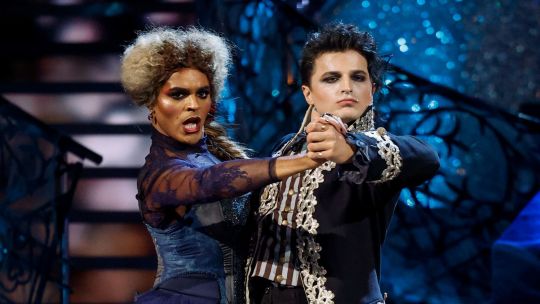
all the ingredients for greatness are here. TANGO. HALLOWEEN. layton is in high goth drag. nikita looks a bit like paul gross as geoffrey tennant as hamlet in the flashback sections of slings and arrows s1. but weirdly i don’t think this dance quite lives up to the level of drama i expected from it. having just rewatched it i think it’s because they’re ACTING like it’s a MELODRAMA, and it FEELS like they’re acting, as opposed to the way they usually totally inhabit the narrative of a dance. however. the switch from this vibe into the denouement - the BACKFLIP (fuck!!!) - and then the breathy, drawn-out final moment, which they suddenly ARE inhabiting, braced over each other and staring into each other’s eyes like they are ON GOD going to fuck in the middle of the dancefloor, is astonishing. once again i am asking the bbc if this is what they thought they were going to air
9. Cha-cha-cha, Week 4

okay. we are entering the section of the list where everything from here on down pretty much makes me feral. layton is everything in that jumpsuit. the THROW into the SPLITS. the raw sexual dynamism somehow contained within nikita taking layton’s coat for him. unbearable.
8. Charleston, Week 12

off the charts crazy. how can people move like this. they CARTWHEELED across the STAGE for what felt like YEARS. points only deducted for the fact that when nikita cried in the interview afterwards because he loved layton so much he had to do it in this extremely silly outfit.
7. Quickstep, Week 2
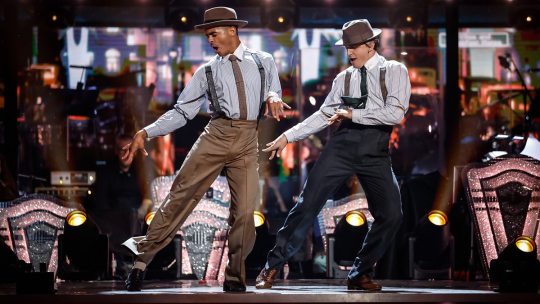
they danced the equivalent of a gay leyendecker illustration in week 2. IN WEEK 2 THEY DID THIS. they’re having so much FUN here. and to follow up on the week 1 ranking, the transformation from them feeling like a professional and a celeb to two people actually dancing together happens SO fast. it’s only a week later, but already something’s changed; layton’s totally at home in the routine and nikita’s REALLY enjoying it. it’s just so nice and i love them so much :’) also the quickstep is one of my favourite strictly dances because it’s inherently funny watching grown adults run full-pelt around a room and occasionally do a little skip. perfect 90 seconds of television.
6. Viennese Waltz, Week 3
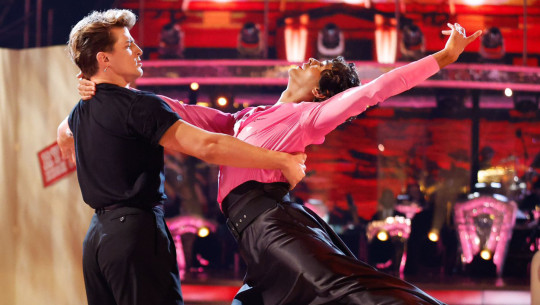
ok so this is actually one of their lowest scoring dances on the show. but NOT according to my ranking. this ought to feel as faux-dramatic as the vampire tango but it doesn’t. something is HAPPENING between them in this dance and it’s real. i could write paragraphs about the eternities contained within the long, long seconds of them holding each other after it’s over, which goes on for long enough that the editor just has to like. give up and cut away from them. i’ve been linking to the bbc’s youtube clips throughout this post, but if you have access to iplayer i strongly recommend you watch this dance as aired (i have linked to the timestamp for your convenience) in order to see the full effect of this ending. there’s something about the combination of… the sincerity of the dance. the gender of it all. the refusal to break character. nikita’s slightly baffled-looking parents in the audience lending whatever the fuck is going on here a bizarre frisson. i’m completely obsessed with it
5. Jive, Week 7
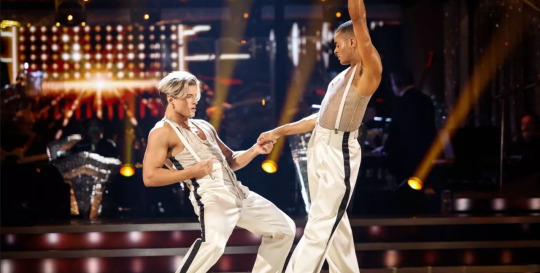
the first thirty seconds of this dance genuinely make me feel like i’m coming up. overwhelming transition from the sexy sexy opening section (why are they dressed as little sailor boys? why are they touching like that?) into the supercharged beat of the side-by-side. people pay good money to feel like this. as has been pointed out, the jive is not a traditionally racy dance, and my question to nikita as choreographer is: why
4. Showdance, Week 13

cunt. cunt. cunt. cunt. the absolute fucking serve of the matching slutty magician elbow-length gloves. nikita dropping his hat while layton executes everything perfectly. obviously in the finale, homophobia won <3 but my god. they ATE. no notes.
3. Paso Doble, Week 11
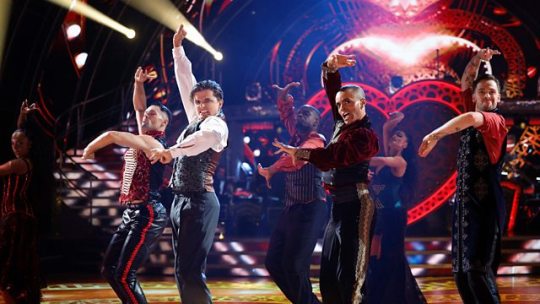
i have said this before. but dancing to BACKSTAGE ROMANCE. in a show where i (facetiously) believe they may be experiencing a BACKSTAGE ROMANCE. seems illegal. anyway. this dance is insane. almost worth them being in the bottom two in week 10 in order for them to produce the unbridled energy of this comeback. as a category the paso doble has similarly melodramatic energy to the tango, but this performance is so unlike the slightly campy vampire number; they’re IN it, they’re living and feeling and breathing every moment. something about the mood of this dance, the power dynamics of it, nikita on the floor looking up at layton in awe as he emerges at his absolute fucking fiercest - happening in THIS week, rising above the stress of relegation and the overwhelming tide of online hate, is, like, pretty incredible, tbh. also the series of searingly erotic snapshot poses at the beginning of this routine are among the worst things i have been subjected to on this show, and as you may be gathering from this list, this is a crowded category.
2. Argentine Tango, Week 8

god it was a TOUGH GODDAMN CALL on these top two places. and tbh i think this is actually, truly, their best dance. the sheer SKILL here… whatever the move is where layton has to jump in the air and kick his little leggies around… stunning. i don’t really have a comical paragraph to write about this because i genuinely think it’s an incredible piece of dance and there’s not much more to add to that. however, extra points for the truly unhinged decision to do some dom nikita roleplay at the end? again, please watch this one on iplayer to experience the full unedited effect.
1. Couple’s Choice, Week 9
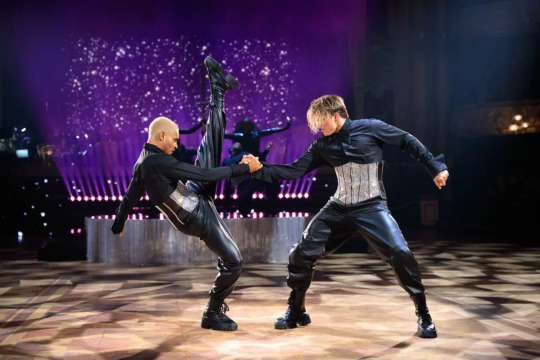
as i say. probably, technically, the argentine tango is better. but if i think about any element of this routine, i immediately black out. i cannot stress enough that he is standing on his back. he is STANDING. on his BACK. nikita choreographed this dance and he was like. i want you to stand on my back. PLEASE don’t worry about it. watching this routine is like looking into the sun. if i saw two men doing this in the club i would have to politely turn away to respect their privacy. also sorry to do this for a final time but i also need you to watch this one on iplayer because nikita stays on that pole at the end for so much longer than you are expecting and then does something sooooo unnecessary. this dance should be expunged from the internet so that i never have to contemplate it again.
#strictly come dancing#scd#if u knew how long i have spent thinking about this. you would say. don't you have a full-time job? and i would say PLEASE leave me alone
194 notes
·
View notes
Text
i'm like so genuinely surprised that considering breaking bad has been one of the most popular and well-acclaimed shows of the past decade that there isn't a larger transformative fandom surrounding it. like there are only 860 works on ao3 for walter/jesse and less than 4k works under the "breaking bad" tag as a whole. i guess that's because it was considered a mainstream, cishet-type show but it really is quite homoerotic and even without that, its honesty and viscerality in portraying long-term abuse is incredible. i compared it to hannibal to one of my friends, except with a greater age gap and even more unequal balance of power (both due to age but also the personalities of the person being manipulated--will vs. jesse).
i think it's a combination of the toxicity of their relationship as well as the concept of the show that prevented breaking bad from being a huge fandom a la tumblr style. because you have hannibal being super popular a decade after it's off the air, but breaking bad is not inherently queer the way hannibal is, both regarding the creators of the show and the content itself. however i think, like supernatural, the show says a LOT about toxic masculinity and is a very smart commentary, and the tumblr girlies would like it if it wasn't just known as a meme online (funny how again, the same thing could be said for the actual subtexts and commentaries of supernatural)
anyway this post came about because i just wish there was more waltjesse fanart</3
#there's so little of it and im a terrible artist it's so sad#like it's not a complete desert but there's way less than i would have expected#waltjesse#heisenbitch#breaking bad#brba#josiah speaks#fandom meta
212 notes
·
View notes
Text
yknow what... Here's a list of Hatchetfield Rarepairs that I think are neat!
Some l've thought up, some may already exist.. Either way I think about them constantly, and I need to share my brainrot.
23oz Chai - Paul 23 / Ted Spankoffski
- workplace crush but, plot twist, one of them is a clone
- Ted confesses, and Paul 23, even though he's unsure if the real Paul would go along with it, accepts anyway.
- everyone in the office reacts to it in shock, and they are convinced it is an elaborate prank. (Its not)
Cat Sweater - Charlotte / Melissa (Charlissa)
- Melissa supports Charlotte through her rocky marriage. Sapphic feelings ensue!
- They bond over their love of cats!
- Crazy cat lady and her sopping wet cat gf!
Dirty Boy - Mark Chasity / Boy Jerry
- Two repressed religious men grappling with internalized homophobia!
- A lot of gay denial and religious guilt in this one!
- Also, Jerry's nature rubs off on Mark a little. Maybe they go a little off the walls together!
Donnapiro - Donna Daggit/ Detective Shapiro
- They start out disliking each other, Shapiro not liking how Hatchetfield News reports crime and Donna despising Shapiro for getting in the way of their journalism
- Slowly, their competition becomes incredibly homoerotic.
- Enemies to lovers, reporter x detective yuri. Solving crimes and being sapphic!
Fast But Pricey - Barry Swift / Frank Pricely (Priceswift)
- I have little justification for this one but.. ldk, I think they would be fun together.
- Frank is just really lonely, let him have a gay lover.
- Their relationships moves fast. (Barry is in a hurry! And Frank is so alone he doesn't mind.)
Latte Bottay - Zoey Chambers / Emmdroid (Zoemdroid)
- They bond over a dislike of the real Emma!
- Zoey is surprisingly chill with the robot thing.
- This also works pretty well with 23ozChai. Paul 23 gets his work crush, Emmdroid gets her work crush, its a win win! bonus wlw mlm solidarity!
Nibblinda - Nibbly / Linda
- Linda treats Nibbly to fine meats and sweets. In return, Nibbly eats her dad and protects her. Overall, a pretty sweet deal!
- Perhaps, they get a little blood on their hands.
- Linda chews people out (figuratively), and Nibbly bites them (literally)
Plastic Cars - Gerald Monroe / Tom Houston
- Hear me out.. Divorced dads realize they are gay... for each other.
- Tim gets a new dad, instead of a new mom.
- Again, I must stress.. middle aged men in love!
Sheiloway - Sheila Young / Miss Holloway
- This is ooc as fuck but the enemies to lovers calls to me.
- They both get someone to confide to about the struggles of lord shenanigans and near immortality
- wlw witches!
Showstoppers - Henry Hidgens / Pokey
- Theater nerds who will murder at the drop of a hat.
- I mean, Pokey did include Show Stopping Number in Inevitable, so that's a little gay.
- They are both just.. really gay tbh.
Spoiled Cat - Linda Monroe / Charlotte Sweetly (Charlinda)
- I think pairing a mean rich lady with a sweet, but this close to losing it, lady is very fun.
- Tbh, I just think the day Charlotte dates a woman is the day her entire world changes.
- Also, I think Charlotte should be allowed to be a little mean for once. Linda would help her be more assertive.
Tentacle Bastard - Wiggly / Ted Spankoffski
- Wiggly steals his brother's toy, and gets more than he bargained for!
- Wiggly tries to scare Ted with his big scary octopus form. It does not have the intended effect!
- Wiggly keeps trying to terrify Ted, but jokes on him Ted is into that, and that flusters him. However, Ted's unabashed bastard confidence has an unexpected side effect: Wiggly catches feelings
Webworship - Webby / Karen Chasity
- Karen finds a new god(dess) to "worship"!
- Unsatisfied wife summons a goddess for some company, and the goddess doesn't mind!
- A little bit of religious guilt in this one, as Karen goes against her beliefs by beginning to "worship" a new god, but its still mostly wholesome!
#paul 23#ted spankoffski#charlotte sweetly#melissa hatchetfield#mark chastity#boy jerry#donna daggit#detective shapiro#barry swift#man in a hurry#frank pricely#zoey chambers#emdroid#nibbly#linda monroe#gerald monroe#tom houston#sheila young#miss holloway#henry hidgens#pokey#pokotho#wiggly#wiggog y'wrath#webby#karen chasity#hatchetfield#hatchetverse#ran out of tag space oops
90 notes
·
View notes
Text



Sword gays showdown preliminaries
Propaganda:
For Kazuma Asogi:
ok so he’s not CANONICALLY queer but it’s ace attorney. so… he does, however, canonically have a katana! a sword so integral to the plot it gives me shivers just thinking about it. the sword also has a name, it’s karuma (translates roughly to karma) and it gets passed onto the main character, ryunosuke naruhodo (who he calls partner), after kazuma (spoiler alert) dies in case 1-2. except (SUPER spoiler alert!) he isn’t dead! he comes back in case 2-3 and would you look at that he has ANOTHER SWORD, a more european sword (cause he ended up in england after his amnesia brain said he REALLY had to go to england). once he gets his memories back, ryunosuke gives karuma back to him and proceeds to use it to destroy the wax figure of his dead presumed serial killer dad (long story), and now he has, you guessed it, TWO SWORDS! for the next two cases he wears both swords at his sides, and also he broke the tip off of karuma attempting to murder someone (he didn’t actually murder anyone but still) and then turns out karuma’s hilt has the REAL serial killer’s will in it. very VERY important sword. in the end, kazuma gives karuma back to ryunosuke which is really symbolic but that’s besides the point, and they cross swords and it’s a whole big thing. 10/10 gay sword guy.
For Raiden:
Man catches knives with his heels and uses a sword to cut through robots 20 times his size
He's such a tragic character! Raised to be a super soldier from birth and is constantly being exploited by the government. As for the lgbt part him and his rival in the latest game he's in have so much tension it's unreal (gay). I headcanon him as trans too because he has a feminine figure, his voice gets more masculine as the series goes on (testosterone) and his entire body gets replaced with cybernetics (trans allegory...)
For Claudine Saijou:
Fights with a longsword! Should be number 1 for this line alone: “For heroes, there are trials. For saints, there are temptations. For me, there is you”, said to def not her girl crush but rival btw (stream Revue of Soul) Vote for my disaster theatre kid its what she deserves!
Her gay levels are off the charts. She has a homoerotic rivalry with another classmate (Maya Tendo/Tendou Maya) that is integral to her character, as she was always first until she met Maya. She’s also half-French, but that’ll be important later. When she’s looking at pictures of Maya stretching (to study her form of course) and another character asks her what she’s looking at, she panics, blushes, and says none of your business. Her and Maya have a heartfelt conversation while stretching with Claudine’s face pressed into Maya’s chest (between her stomach and breasts). Some art from a magazine has Maya pushing Claudine into a deep stretch, but it looks like something a lot different (Claudine blushing doesn’t help. Also I realized that there’s a lot of gay stuff related to stretching with these two).
During a two on two duel (I know it’s not a duel), they fight together. Not only that, but at one point they hold hands and take a pose typical of romantic partners in dancing. For no reason. They just pause and do it to show off. They aren’t even fighting. Anyways, when they lose, Claudine starts crying, not because she lost, but because Maya lost. So, of course, Maya starts speaking to her in French, with one of the things she says being “You’re cute even when you cry, my Claudine.” All of this is stuff that’s happened in the series (except the magazine thing).
Now for the gay stuff in the movie. Their duel with each other is so dense with sapphic undertones they can hardly be called undertones. For starters, the song that accompanies this revue is called “A Beautiful Person, or Perhaps it is.” While this title is incomplete, the director states that he wanted the watcher to fill it in and this removed the end of the original title. That title is “A Beautiful Person, or Perhaps it is a Love Song.” The duel is framed as a fight between a hero (Maya) and a devil (Claudine). Maya is in an outfit reminiscent of Renaissance Italy and Claudine is in a suit. Thus, Maya signs a contract giving her soul over to Claudine, as is the case with marriage. With her own blood, in the shape of Position Zero (an important symbol in the show), which happens to look like a T, for Tendou. After a few minutes of fighting, Maya disappears and monologues, appearing in a white dress. This means that Maya has signed her soul over to Claudine, and they are now both wearing a white dress and suit. Not beating the gay marriage allegations. Maya finished her monologue with “For heroes, there are trials. For saints, there are temptations. For me, there is a devil.” They continue to fight, Maya proclaiming herself emotionless and empty. Maya then cuts the medallion from Claudine’s chest (they wear medallions and you lose the duel if it gets cut off).
Claudine falls. Maya attempts to claim victory by stabbing her sword into Position Zero, which is then covered by steel doors. Claudine sits up and reveals she has another medallion in her mouth, which she does by sticking out her tongue in a uhhhh. Anyways, after a bit of back and forth, Claudine tells Maya that she’s full of arrogance and pride and envy and longing. She then says that “No matter how many times I die, I will revive! Tendou Maya! To beat you, my rival, into submission!” She then makes her stage entrance, taking Maya’s usual entrance speech and mocking it. She also says “I fill myself with exploding passion, now, and bash it into your heart!” After some talking, Maya makes her stage entrance, taking Claudine’s usual entrance speech and mocking it. Up until now, they have been playing characters, but still letting their own emotions shine through. Now, they are entirely themselves.
They begin to fight again, running downs white aisle before clashing swords, with Maya saying “Such an ugly, emotion drenched appearance-“ and is cut off by Claudine, who says “Show me more, Tendou Maya! Right now, you’re the cutest you’ve ever been!” To which Maya responds “I’m always cute!” The song starts up again (duels are accompanied by songs), with Maya singing “With a grin of deception I’ll tear this piece of cloth.” Deception in Japanese is mayakashi, a reference to Maya’s name. Maya then sings “I want to show you my feelings becoming dyed in black.” Black is Kuro in Japanese. Claudine, in Katakana, is Kurodine, with her nickname being Kuro, so that line could also be interpreted “I want to show you my feelings becoming dyed in you.” Claudine then sings “Only me, always, forever,” before they sing in unison “You only need to look at me,” as they lock blades. Some fighting happens and they’re falling through the sky, holding onto each others clothes and Claudine says “Only I can make you lay everything bare!” To which Maya responds “I’ll expose my everything, on the stage!” Claudine shoots back with “There’s a partner you can expose everything to, on the stage!” At this point, there’s a short time with independent vocals for Maya and Claudine in addition to their talking. Maya has been singing “If I’m on the stage, if I’m in front of you,” for the last two lines of dialogue. Claudine sings “Be it ugly or beautiful,” as Maya sings “I will expose, anything and everything, all of me, all of me.” As this happens, Maya is saying “We love the stage,” which is continued by Claudine saying “And we can’t part from the stage!” Maya calls them both “Pathetic clowns!” To which Claudine corrects “No, rivals!” Maya says “If you’re there, I have to strive higher!” Claudine says “You make me even more beautiful! Maya!” Maya then yells “Claudine!” Claudine yells “For heroes, there are trials!” Maya continues “For saints, there are temptations!” Then, as one, their swords crossed, faces inches from each other, yell “For me, there is you!” Over top of this, their voices sing a line in unison: “Forever and ever, I’d like to cross swords with you.”
Claudine’s sword stabs through the contract, through the Position Zero in blood, which may be Maya’s family name, and Maya says as an aside “Saijou Claudine… You are beautiful.” Claudine cuts the medallion from Maya’s chest, finally beating her rival.
#sword gays showdown#claudine saijou#raiden#revue starlight#metal gear solid#kazuma asogi#the great ace attorney#shojo kageki revue starlight#mgs#ace attorney
173 notes
·
View notes
Text
btw these are just some of the yellowjackets dynamics btw. To Me.
tainat are two cousins who are best friends they vanish every family holiday to go "take a walk" aka get fucking blazed down the block from their aunt's house
vanlottie are like okay. you are my master i am your disciple no you are my patient i am your nurse no you are my god and i made you a god no you are my salvation and i am begging you to stay there. bottom4service top.
taishauna are like okay youre wives but it's not romantic. youre life partners but it's not romantic. youre chosen soulmates but it's not romantic but it Is but you have never fucked and even if you did it wouldnt change anything . taishauna are like okay we are common law besties we are bound to each other by something deeper than anywhere else. taishauna said what if we were teh one healthy dynamic either of us is ever going to have with anyone. they said what if we were best friends forever. they said What If We Were Best Friends Forever.
shaunajackie is homoerotic girlbesties who kill each other what more has to be said than has already been said. theyre cathy and heathcliffe and theyre both girls and what if they kissed except they WONT and thats the POINT if they could kiss they wouldnt kill each other but they have to kill each other so.
lottienat are like . this is the most complex and profound relationship two people can have to each other is if one of them is charlotte isobel matthews and the other is natalie something italian scatorccio. if you ask me to describe it in words i cant. however i Can start crying and the crying will Hurt and that will explain it. they are the same person. im cradling them in my hands. they have known each other in every lifetime. they cant fucking stand each other and they are the only people each other can stand.
mistynat are like what if two very different kind of cats got fixated on each other by accident and now they will chase each other to the ends of the earth in increasing madcap schemes mistynat is tom and jerry . mistynat is like you know that bit at the end of pride and prejudice when everyones like. lizzie and darcy??? what????? that's mistynat to the rest of the yellowjackets . mistynat is a happy awful lab accident <3 and theyre kissing <3
shaunanat is like two siblings who are trying to kill each other and would kill for each other i'd say it in more words but i dont need it
shaunalottie is like. okay we're gonna be weird about each other forever in increasingly complex and disgusting ways yes it's gay but that's just part of it. we're dismembering each other but that's also just part of it. shaunalottie is like okay ill beat you nearly to death and youll be weird about my offspring in blood cult ways. those are real things that happened.
vannat are like oh ive known you since before i can remember what words even were .
227 notes
·
View notes
Text
okay listen. I get the urge to talk about my favorite life series ship like it's Canon in every season...BUT. THAT HAS NEVER ONCE BEEN THE CASE.
Yes, Jimmy would be upset if Tango canaried (technical scientific term for that). Everyone would be- even I would be, and I've never watched a single one of his videos. Canarying sucks, and it hurts. Of course I would be upset. THAT DOES NOT MEAN THAT I THINK JIMMY WOULD BREAK DOWN SOBBING FROM A CHARACTER STAND POINT. They have had only like... THREE on screen interactions. One is Tango murdering a man infront of Jimmy and another is Tango cheerfully burning down something one of Jimmy's teammates worked very hard on. WildLifeChara!Jimmy has more reason to hate or be afraid of WildLifeChara!Tango than to be madly in love with him.
I promise you, if Tango had offered Jimmy a life instead of Ren, people wouldn't shut up about for MONTHS. But, because it's Ren, somehow the interaction isn't NEARLY as homoerotic??? I understand having NOTP's, but the Jimmy/Ren ship doesn't even show up ONCE on ao3. Zero fics. ZE-RO. There's no reason to hate something that doesn't even exist.
This same concept applies for Flower Husbands as well- not just in Wild Life, and Secret Life and Limited Life and Last Life and Real Life though- in Empires.
I have no clue about Empires Season 1, but they barely interacted in Empires Season 2- and yet the amount of ship art I sift through on a weekly basis for my side blog is actually insane. Yeah, the few interactions WERE important, but I think Scott only flirted (in video) with Jimmy maaybbeeee three times. I have no idea what the count of that for streaming is, but I swear it is not enough to keep that number so inflated.
Although, honestly, this problem might just be affecting me because of my personal view on shipping- if it's in a context where it doesn't make sense for the characters to be romantically engaged, I won't read it or write it.
For example, my beloved Solidwood! I mostly get their vibes or read their fics from the following series: Evo, Last Life, New Life, Empires2, Secret Life. That's because those settings make sense! They are active, they are engaged, they have near constant interactions or very close base locations. It makes SENSE for them to be shipped. However, if you showed me art or fic of them in, say, Limited Life, I'd furrow my brow and tilt my head and say "no, that doesn't do anything for me." BECAUSE THEY HAVE ZERO REASON TO BE INVESTED ROMANTICALLY IN ONE ANOTHER THERE, AS A STAND ALONE SETTING.
Most of the major Jimmy ships, though, don't follow this rule. I can understand loving a ship so much you want to see it everywhere- but, I promise you, stepping back and looking at which characters actually have chemistry regarding the new setting and social system will do wonders... you won't have to think of new Au's to insert your favorite ship into a new setting... all ships will be your favorite ship (unless they give you the ick). Join the multishiper hivemind /j
No but honestly it's gotten to the point where I will like or dislike a creator/character of theirs by what ship is their most popular given the context of the setting. Like, Tango in Double Life? Awww the sweetie!! I love him :) and then Tango in Empires2 sets off alarm bells in my brain screaming at me. He is NOT meant to be here bringing that ship here, this is NOT its territory. Same problem for Scott in nearly damn near every SMP both Jimmy and him are in... except Wild Life because he's actually been pretty nice and not condescending or forcing on Jimmy. I guess also power imbalances in how fans view them is a major no-go for me...
Idk if you read this whole thing thanks I guess... for anymore needed context I am a Jimmy rarepair obsessed multishiper.
TLDR; Lots of popular ships are inserted into settings without a thought for what that would mean for the setting and any changes in the established social connections, which gives OP the ick. I'm also not policing ships I'm just begging people to please either understand more ships using in setting context or list their AU details in the summaries of the fics. This goes hand in hand with misinterpreting characters in writing also... the more ships you like the more characters you will get to get good at writing!!!!
#Realized why the reason some creators leave a bad taste in my mouth is because their main ship's fanbase#Shoves that ship into everything. Even places it shouldn't be. For example a crazy amount of the Jimmy empires fics#Are au's of Esmp1 where Tango rules a kingdom in the Nether. Yeah its a fun idea but if it dominates HALF of the tags its...#It's just kinda spam at that point. He's not even in that smp and I'll bet Tango is tagged more than one of the Canon emperors#And the nearly the other half of Jimmy Empires fics are god damn FLOWER HUSBANDS. YOU CANT ESCAPE THEM#And also Scott even shoves the ship on Jimmy. Did you not SEE THEIR INTERACTION IN REAL LIFE???#JUST REALIZES THATS WHY I WAS ABLE TO READ A FLOWER HUSBANDS FIC ONCE.BEVAUSE THE WRITER MADE THEM SEEM LIKE EQUALS#fandom discourse#fandom discussion#shipping discourse#shipping discussion#creacheurspeacher#ship and let ship#life series#life smp#trafficblr#solidaritygaming#jimmy solidarity#traffic smp#scott smajor#smajor1995#tangotek#wildlife smp#trafficshipping#long post#rant post#shipping rant#flower husbands#the ranchers#solidwood
29 notes
·
View notes